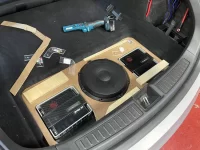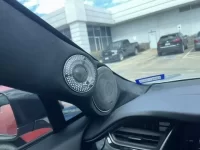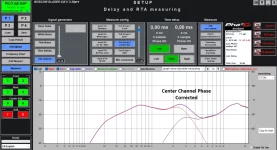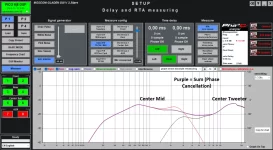Part 3 - What i wanted to get out of an aftermarket system
I probably should have started with this, but nonetheless i think it would be helpful context for me to share what I was looking to get out of the aftermarket system (and where i felt the Lucid OEM system could be improved)
Some background context on me as a buyer:
I began my HiFi journey with my 2016 Model S. Originally because I like many others felt the bass was lacking. After looking at all the DIY mods that were available, i came to the conclusion i didn't need a project to hack on for which i knew nothing about. So I called a few shops and ended up working with Sound Innovations. As a Neophyte buyer, i needed education on just about everything. First starting with the: Can you throw a Sub in it and make the bass not suck? (Back then i thought the Model S Premium sound was a decent system)
Fast forward through the sales process (and the initial quotes) I wasn't bought in on the 5 figure build. Back then that was a mind blowing number to spend on audio when pretty much everything else was a $2-4k upgrade from the factory.
So i started with a "Value" system. At the time it meant having a DSP, a 4 channel Amp, and the Hertz line of aftermarket 2 way drivers and a subwoofer in a off the shelf box enclosure that was shoved into the trunk footwell of the model S. Probably <$4k build. Wow it improved a lot. Didn't know it could get that much better (and that was the low end aftermarket system!)
I later upgraded that system 2 more times to improve the drivers all around, improve the subwoofer driver and a custom enclosure for the sub so it wasn't sitting in the sub frunk where it was getting muffled. Here's a picture of the "visible" part of that system: the 12" sub.
What you should know about aftermarket car audio:
I know some readers here are avid HiFi nuts, and others are just curious like me and perhaps somewhat intimidated by the cost and all the jargon in the space. My goal is to help those who are just starting their Aftermarket Audio journey get a sense of what they are walking into.
1.) You have to realize that for most Auto OEMs, the sound system does not get high priority in the system design. (When was the last time you bought a car because it had an awesome stock stereo system?) Guess where all the attention, design, and Bill of materials cost goes to. Stuff that sells cars, engine, suspension, interior you get the idea. So what happens to the poor audio system? Well it tends to get last priority in the packaging of the vehicle. The speakers are located where they will fit and often where it's easy to install since they are mass producing and servicing these vehicles. The classic bad placement are the doors (because they are basically a empty resonance chamber).
2.) OEM's need to make money off their options, so when you buy the $2-4k Stereo upgrade in the car, there might be $400 of components in there, that often have to be split between 8-10 drivers and an amplifier. That really not a lot of $$ to go around. Oh and acoustic treatment? Yeah that's just extra weight in the vehicle that doesn't help the OEMs score points on their EPA ratings.
3.) So when you have typically poorly placed speakers and low quality components that often means that the system tuners of the OEM system are stuck trying to do their best with very little to work with. Oh and by the way the OEM tuners don't know who the main listener for the system is so they have to tune the system to sound "OK" for everyone. That's a lot different than knowing the exact seating position of the person who cares about the audio.
That means that someone who knows what they are doing with a Bill of materials in the $1-2k range (5x that of a stock system) are literally working with 5x the materials and can select components based on budget that address the design limits of the stock car audio. Getting better bass often means adding power and a driver that can take that power, but the system tuning especially with DSPs now is just as important because otherwise you'll just get more power fighting the rest of the system.
So what about Lucid's stock audio?
As many readers have noted. Lucid's stock audio is actually quite good. The reason for this primarily i believe is that along with Lucid's philosophy of fully integrated system design - the audio system was not an afterthought. It had a seat at the table during the design and packaging process so it didn't just get crammed where it would fit. Certainly input from Dolby i am sure was influential because the idea of atmos was 3d audio, which is hard to execute if your speakers are not positioned properly to do it. The net of it is that even with hard bill of materials limits, the general layout of the speakers was about as good as you can get for a stock build. As well Lucid didn't totally skimp on acoustic treatment so the cabin noise while perhaps not the quietest in the space was better than average. This means you have a listening environment that for a car is on the ideal side. With cars nothing is perfect because all that glass really isn't good for audio (due to the reflections that it causes).
So what i felt held Lucid's audio back primarily was the resolution of the audio and bass output. Primarily due to component quality and the design decision to seal the trunk (thus requiring a free air subwoofer in infinite baffle configuration which reduces bass output and the fact that the rear driver is only 8" (likely a packaging limitation as you can see on the rear deck which the cutout is for the sub.
You'll find that for tracks like electronic music, synthetics etc. Lucid's system actually performs quite well. Those types of music don't test the resolution of the stock drivers as much as say vocals or strings that have many higher order harmonics.
What i prioritized as now a more informed buyer
Anyone who spends time in the Hifi world will understand the statement that: There is really no limit on how much money you can spend. You can literally chase perfection for forever and spend a fortune on it.
While I have the fortune of being well off enough to comfortably afford my Lucid, my budget is not infinite.
So i said the following were my priorities.
1.) I wanted to preserve the stock packaging of the car. e.g. no custom enclosures, eating up trunk space or drilling holes. At the end of the day this is still a car you need to be able to use and drive around and Lucid spent so much effort on packaging it would be a waste to disrupt that design.
2.) My preference given that the stock system was actually pretty clean and didn't need a ton of remediation to correct material system flaws was to improve the resolution on the mids / highs. I wanted more bass as well, but not at the tradeoff of needing custom work. (I loved my 12" sub in the Model S, that thing would hit hard like you were in a live rock concert) but i would be OK without it.
3.) I kept the Power Amps Class D because at the end of the day, while i enjoy the texture of a class A/B amp (I have a decent Parasound for home audio) it wasn't worth the additional battery drain, heat, and space that the amps would take up.





